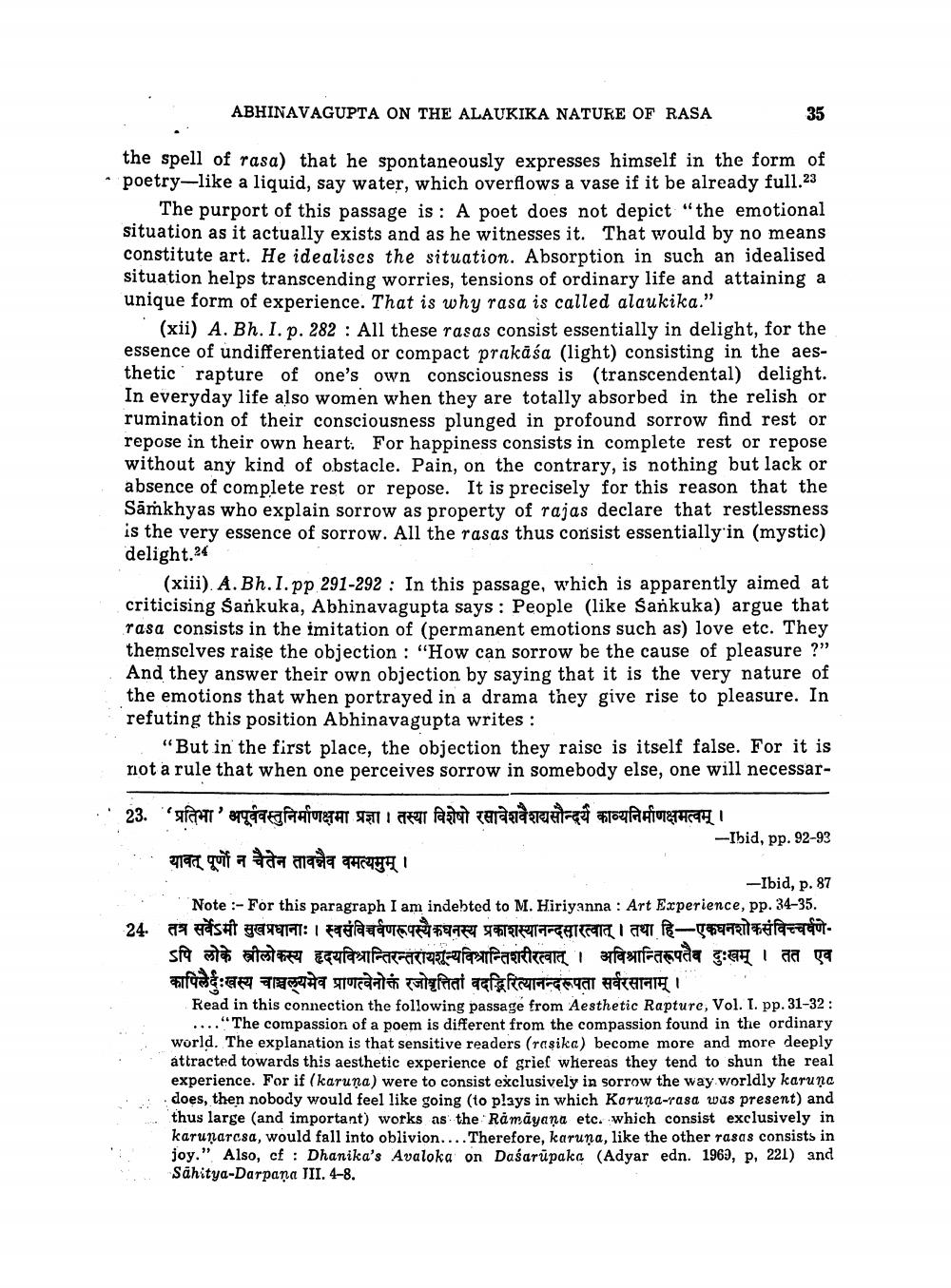________________
ABHINAVAGUPTA ON THE ALAUKIKA NATURE OF RASA
35
the spell of rasa) that he spontaneously expresses himself in the form of poetry-like a liquid, say water, which overflows a vase if it be already full.23
The purport of this passage is : A poet does not depict "the emotional situation as it actually exists and as he witnesses it. That would by no means constitute art. He idealises the situation. Absorption in such an idealised situation helps transcending worries, tensions of ordinary life and attaining a unique form of experience. That is why rasa is called alaukika."
(xii) A. Bh. I. p. 282 : All these rasas consist essentially in delight, for the essence of undifferentiated or compact prakāśa (light) consisting in the aesthetic rapture of one's own consciousness is (transcendental) delight. In everyday life also women when they are totally absorbed in the relish or rumination of their consciousness plunged in profound sorrow find rest or repose in their own heart: For happiness consists in complete rest or repose without any kind of obstacle. Pain, on the contrary, is nothing but lack or absence of complete rest or repose. It is precisely for this reason that the Samkhyas who explain sorrow as property of rajas declare that restlessness is the very essence of sorrow. All the rasas thus consist essentially in (mystic) delight.24
(xiii). A.Bh. I. pp 291-292 : In this passage, which is apparently aimed at criticising Sankuka, Abhinayagupta says : People (like Sankuka) argue that rasa consists in the imitation of (permanent emotions such as) love etc. They themselves raise the objection : "How can sorrow be the cause of pleasure ?" And they answer their own objection by saying that it is the very nature of the emotions that when portrayed in a drama they give rise to pleasure. In refuting this position Abhinavagupta writes :
"But in the first place, the objection they raise is itself false. For it is not a rule that when one perceives sorrow in somebody else, one will necessar
. 23. afdall'engage ATHITTAT FENT I datat chandragite loadinara.cat
-Ibid, pp. 92-93 ... यावत् पूर्णो न चैतेन तावन्नैव वमत्यमुम् ।
-Ibid, p. 87 Note :- For this paragraph I am indebted to M. Hiriyanna : Art Experience, pp. 34-35. 24. तत्र सर्वेऽमी सुखप्रधानाः । स्वसंविचर्वणरूपस्यैकघनस्य प्रकाशस्थानन्दसारत्वात् । तथा हि-एकघनशोकसंविच्चर्वणे
ऽपि लोके स्त्रीलोकस्य हृदयविश्रान्तिरन्तरायशून्यविश्रान्तिशरीरत्वात् । अविश्रान्तिरूपतैव दुःखम् । तत एव कापिलैर्दुःखस्य चाञ्चल्यमेव प्राणत्वेनोक्तं रजोवृत्तितां वदद्भिरित्यानन्दरूपता सर्वरसानाम् ।
Read in this connection the following passage from Aesthetic Rapture, Vol. I. pp. 31-32:
...." The compassion of a poem is different from the compassion found in the ordinary world. The explanation is that sensitive readers (rasika) become more and more deeply attracted towards this aesthetic experience of grief whereas they tend to shun the real experience. For if (karuņa) were to consist exclusively in sorrow the way worldly karuņc does, then nobody would feel like going (to plays in which Koruna-rasa was present) and thus large and important) works as the Ramayana etc. which consist exclusively in karunarcsa, would fall into oblivion.... Therefore, karuna, like the other rasas consists in joy." Also, cf : Dhanika's Avaloka on Dasarūpaka (Adyar edn. 1963, p. 221) and Sahitya-Darpaņa TII. 4-8.




